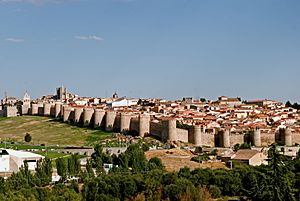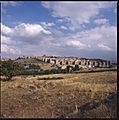Walls of Ávila facts for kids
The Walls of Ávila are amazing old walls in central Spain. They were finished between the 11th and 12th centuries, which means they are over 800 years old! These walls are the most important historical landmark in the city of Ávila.
About the Walls of Ávila
The building of these walls started in 1090. A person named Raymond of Burgundy began the project. Most of the walls were rebuilt in the 12th century.
The area inside the walls is shaped like a rectangle. It covers about 31 hectares, which is like 76 football fields! The total length around the walls is about 2,516 meters. Along the walls, there are 90 round towers with notched tops, like a castle.
The walls are about 3 meters wide and stand about 12 meters tall. There are nine strong, fortified gates to enter the city. Two of the most famous gates are the Puerta de San Vicente (St Vincent's Gate) and the Puerta del Alcazar (Fortress Gate). Each of these gates has two tall towers, about 20 meters high, connected by a rounded archway.
Even the back part of the city's cathedral is built into the walls, acting like one of the towers! These walls are known as the most complete old fortifications in all of Spain.
You can walk on top of the walls for about half of their total length. Some parts cannot be walked on because they are connected to other buildings. Also, a large part of the walls is not safe for people to walk on yet.
The Walls of Ávila were made a National Monument in Spain in 1884. Later, in 1985, the old city of Ávila and its churches outside the walls were named a World Heritage Site by UNESCO. This means they are very important and protected by the world.
Gallery
- The information in this article is based on that in its Spanish equivalent.
Images for kids
See also
 In Spanish: Muralla de Ávila para niños
In Spanish: Muralla de Ávila para niños









